Comprehensive Report: Managing Information System at Tesco
VerifiedAdded on 2020/07/22
|11
|2585
|70
Report
AI Summary
This report provides a comprehensive analysis of Tesco's information system management. It begins with an overview of the organization, including its business type, products, market, customers, mission, culture, and organizational structure. The report then delves into Tesco's current business strategies and the competitive environment, examining political, economic, and social factors. A significant portion of the report focuses on the status of IS implementation within Tesco, detailing the various information systems deployed, such as Office Automation System (OAS), Transaction Processing System (TPS), Management Information System (MIS), Decision Support System (DSS), and Executive Support System (ESS), and their impact on the company's performance, including operational excellence, new product launches, and improved decision-making. The report concludes by emphasizing the necessity of information systems for optimizing organizational performance and achieving business objectives.
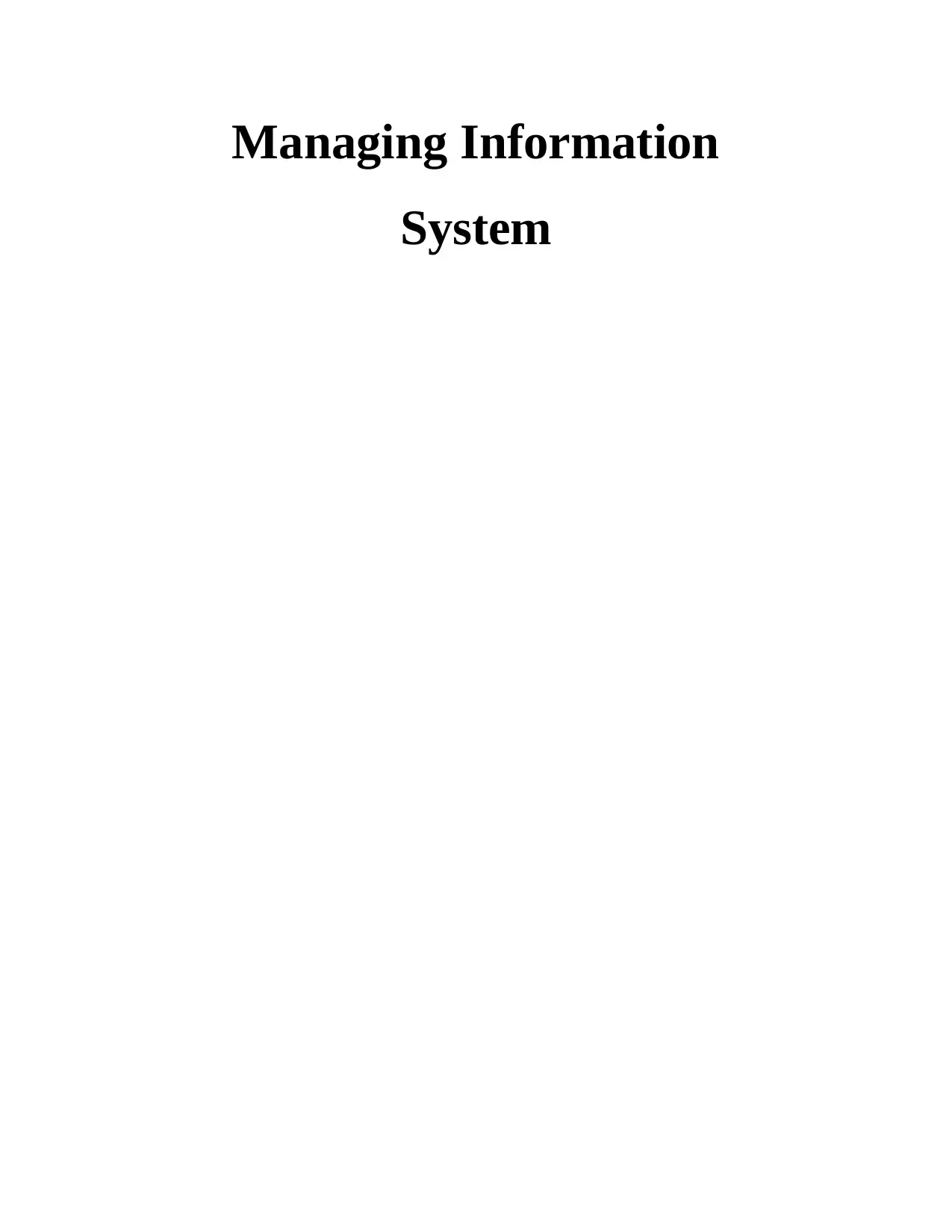
Managing Information
System
System
Paraphrase This Document
Need a fresh take? Get an instant paraphrase of this document with our AI Paraphraser
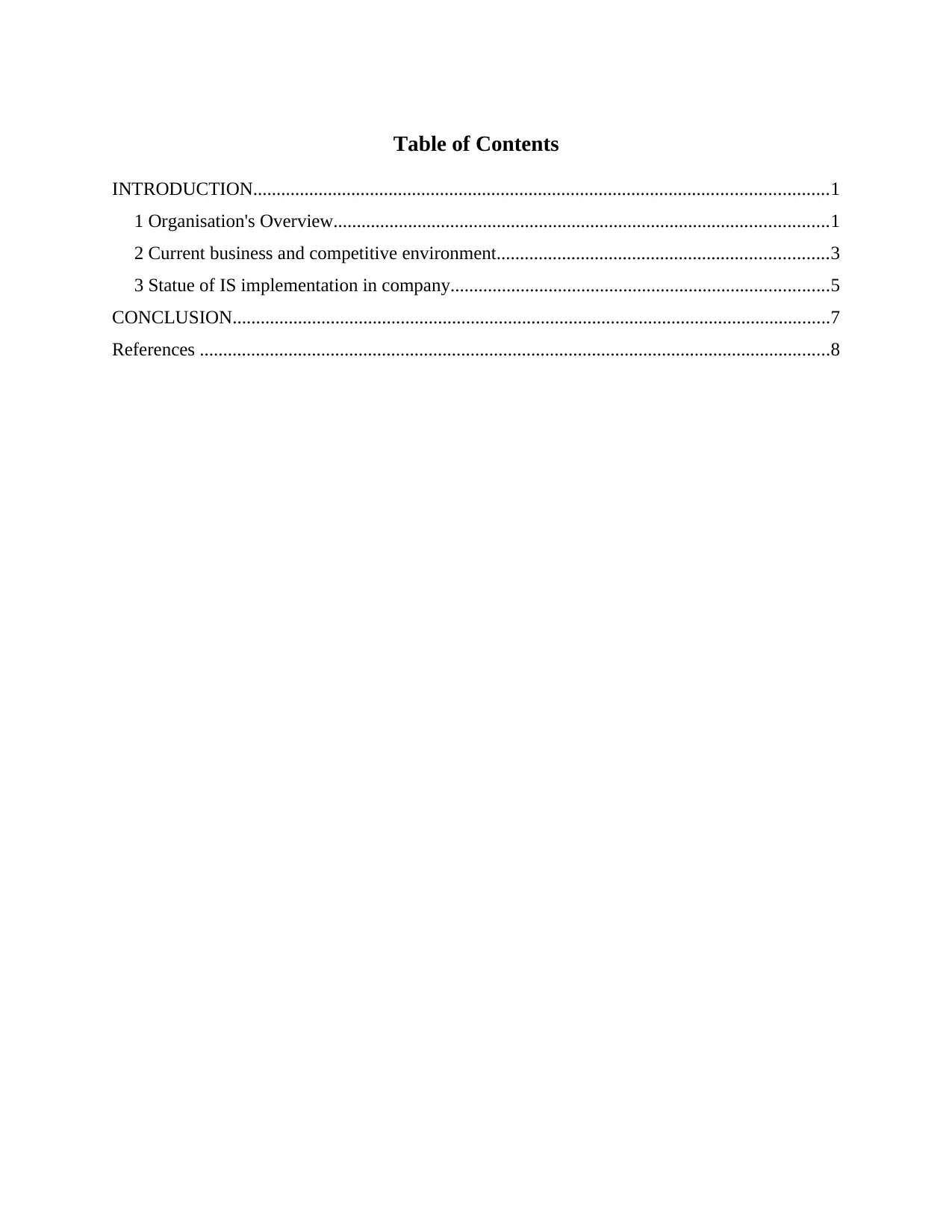
Table of Contents
INTRODUCTION...........................................................................................................................1
1 Organisation's Overview..........................................................................................................1
2 Current business and competitive environment.......................................................................3
3 Statue of IS implementation in company.................................................................................5
CONCLUSION................................................................................................................................7
References .......................................................................................................................................8
INTRODUCTION...........................................................................................................................1
1 Organisation's Overview..........................................................................................................1
2 Current business and competitive environment.......................................................................3
3 Statue of IS implementation in company.................................................................................5
CONCLUSION................................................................................................................................7
References .......................................................................................................................................8
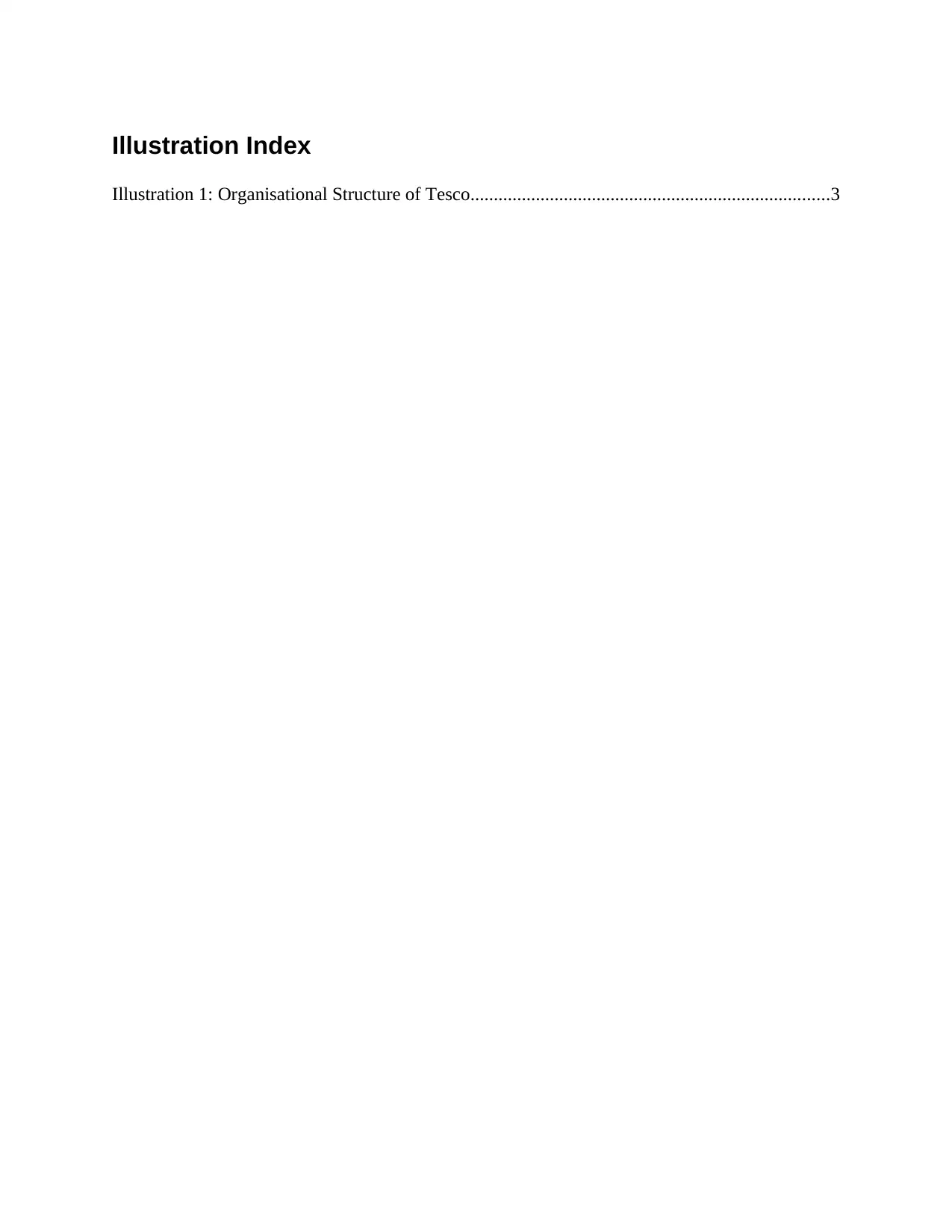
Illustration Index
Illustration 1: Organisational Structure of Tesco.............................................................................3
Illustration 1: Organisational Structure of Tesco.............................................................................3
⊘ This is a preview!⊘
Do you want full access?
Subscribe today to unlock all pages.

Trusted by 1+ million students worldwide
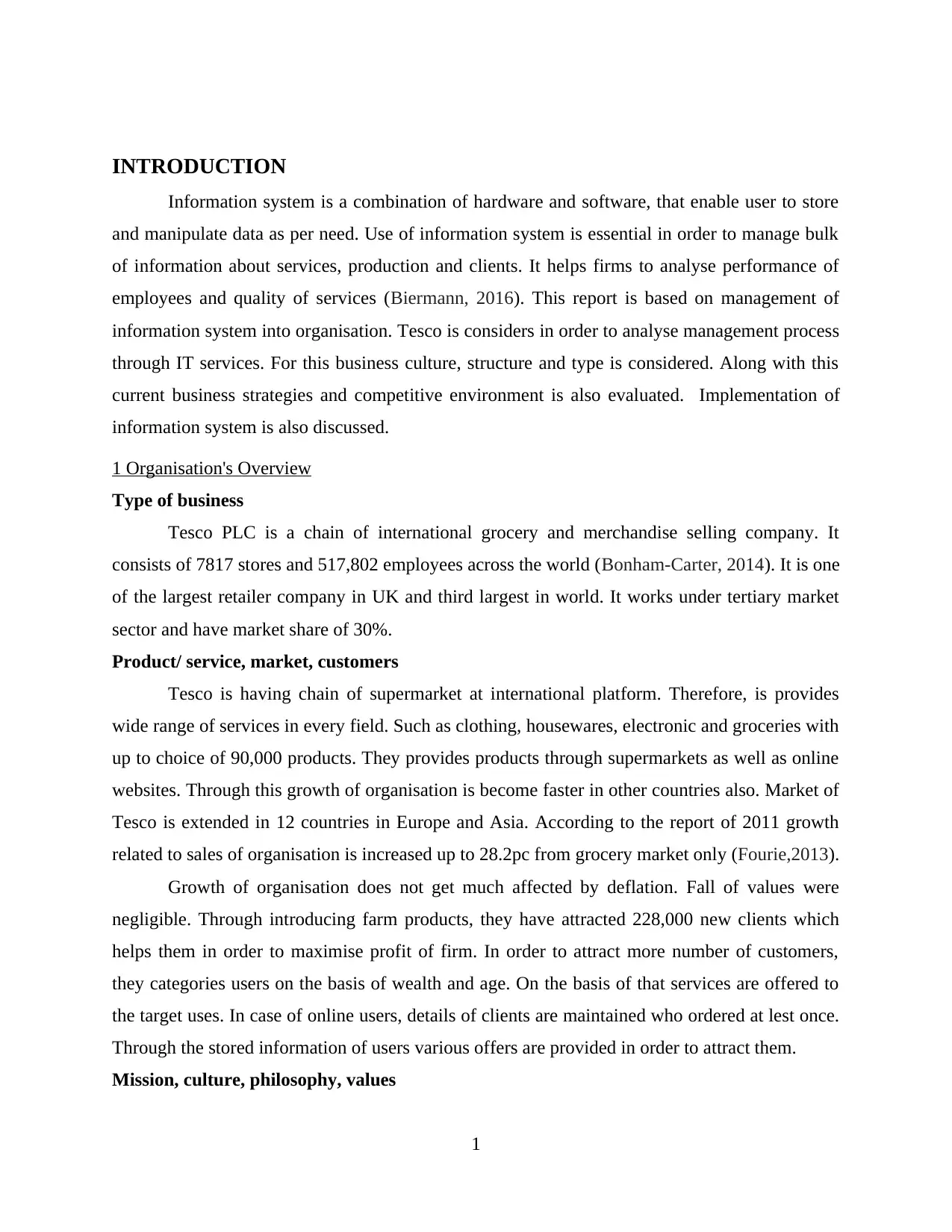
INTRODUCTION
Information system is a combination of hardware and software, that enable user to store
and manipulate data as per need. Use of information system is essential in order to manage bulk
of information about services, production and clients. It helps firms to analyse performance of
employees and quality of services (Biermann, 2016). This report is based on management of
information system into organisation. Tesco is considers in order to analyse management process
through IT services. For this business culture, structure and type is considered. Along with this
current business strategies and competitive environment is also evaluated. Implementation of
information system is also discussed.
1 Organisation's Overview
Type of business
Tesco PLC is a chain of international grocery and merchandise selling company. It
consists of 7817 stores and 517,802 employees across the world (Bonham-Carter, 2014). It is one
of the largest retailer company in UK and third largest in world. It works under tertiary market
sector and have market share of 30%.
Product/ service, market, customers
Tesco is having chain of supermarket at international platform. Therefore, is provides
wide range of services in every field. Such as clothing, housewares, electronic and groceries with
up to choice of 90,000 products. They provides products through supermarkets as well as online
websites. Through this growth of organisation is become faster in other countries also. Market of
Tesco is extended in 12 countries in Europe and Asia. According to the report of 2011 growth
related to sales of organisation is increased up to 28.2pc from grocery market only (Fourie,2013).
Growth of organisation does not get much affected by deflation. Fall of values were
negligible. Through introducing farm products, they have attracted 228,000 new clients which
helps them in order to maximise profit of firm. In order to attract more number of customers,
they categories users on the basis of wealth and age. On the basis of that services are offered to
the target uses. In case of online users, details of clients are maintained who ordered at lest once.
Through the stored information of users various offers are provided in order to attract them.
Mission, culture, philosophy, values
1
Information system is a combination of hardware and software, that enable user to store
and manipulate data as per need. Use of information system is essential in order to manage bulk
of information about services, production and clients. It helps firms to analyse performance of
employees and quality of services (Biermann, 2016). This report is based on management of
information system into organisation. Tesco is considers in order to analyse management process
through IT services. For this business culture, structure and type is considered. Along with this
current business strategies and competitive environment is also evaluated. Implementation of
information system is also discussed.
1 Organisation's Overview
Type of business
Tesco PLC is a chain of international grocery and merchandise selling company. It
consists of 7817 stores and 517,802 employees across the world (Bonham-Carter, 2014). It is one
of the largest retailer company in UK and third largest in world. It works under tertiary market
sector and have market share of 30%.
Product/ service, market, customers
Tesco is having chain of supermarket at international platform. Therefore, is provides
wide range of services in every field. Such as clothing, housewares, electronic and groceries with
up to choice of 90,000 products. They provides products through supermarkets as well as online
websites. Through this growth of organisation is become faster in other countries also. Market of
Tesco is extended in 12 countries in Europe and Asia. According to the report of 2011 growth
related to sales of organisation is increased up to 28.2pc from grocery market only (Fourie,2013).
Growth of organisation does not get much affected by deflation. Fall of values were
negligible. Through introducing farm products, they have attracted 228,000 new clients which
helps them in order to maximise profit of firm. In order to attract more number of customers,
they categories users on the basis of wealth and age. On the basis of that services are offered to
the target uses. In case of online users, details of clients are maintained who ordered at lest once.
Through the stored information of users various offers are provided in order to attract them.
Mission, culture, philosophy, values
1
Paraphrase This Document
Need a fresh take? Get an instant paraphrase of this document with our AI Paraphraser
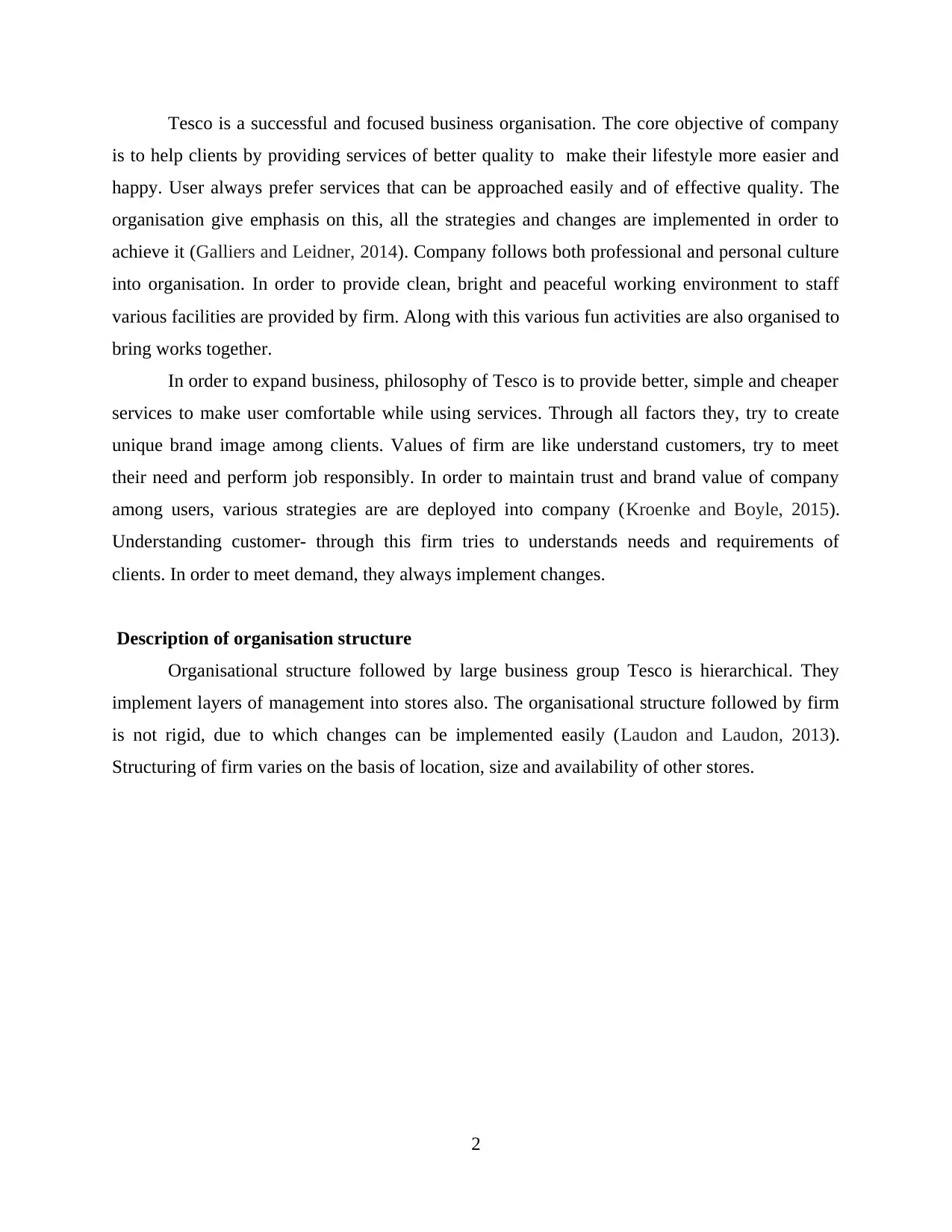
Tesco is a successful and focused business organisation. The core objective of company
is to help clients by providing services of better quality to make their lifestyle more easier and
happy. User always prefer services that can be approached easily and of effective quality. The
organisation give emphasis on this, all the strategies and changes are implemented in order to
achieve it (Galliers and Leidner, 2014). Company follows both professional and personal culture
into organisation. In order to provide clean, bright and peaceful working environment to staff
various facilities are provided by firm. Along with this various fun activities are also organised to
bring works together.
In order to expand business, philosophy of Tesco is to provide better, simple and cheaper
services to make user comfortable while using services. Through all factors they, try to create
unique brand image among clients. Values of firm are like understand customers, try to meet
their need and perform job responsibly. In order to maintain trust and brand value of company
among users, various strategies are are deployed into company (Kroenke and Boyle, 2015).
Understanding customer- through this firm tries to understands needs and requirements of
clients. In order to meet demand, they always implement changes.
Description of organisation structure
Organisational structure followed by large business group Tesco is hierarchical. They
implement layers of management into stores also. The organisational structure followed by firm
is not rigid, due to which changes can be implemented easily (Laudon and Laudon, 2013).
Structuring of firm varies on the basis of location, size and availability of other stores.
2
is to help clients by providing services of better quality to make their lifestyle more easier and
happy. User always prefer services that can be approached easily and of effective quality. The
organisation give emphasis on this, all the strategies and changes are implemented in order to
achieve it (Galliers and Leidner, 2014). Company follows both professional and personal culture
into organisation. In order to provide clean, bright and peaceful working environment to staff
various facilities are provided by firm. Along with this various fun activities are also organised to
bring works together.
In order to expand business, philosophy of Tesco is to provide better, simple and cheaper
services to make user comfortable while using services. Through all factors they, try to create
unique brand image among clients. Values of firm are like understand customers, try to meet
their need and perform job responsibly. In order to maintain trust and brand value of company
among users, various strategies are are deployed into company (Kroenke and Boyle, 2015).
Understanding customer- through this firm tries to understands needs and requirements of
clients. In order to meet demand, they always implement changes.
Description of organisation structure
Organisational structure followed by large business group Tesco is hierarchical. They
implement layers of management into stores also. The organisational structure followed by firm
is not rigid, due to which changes can be implemented easily (Laudon and Laudon, 2013).
Structuring of firm varies on the basis of location, size and availability of other stores.
2
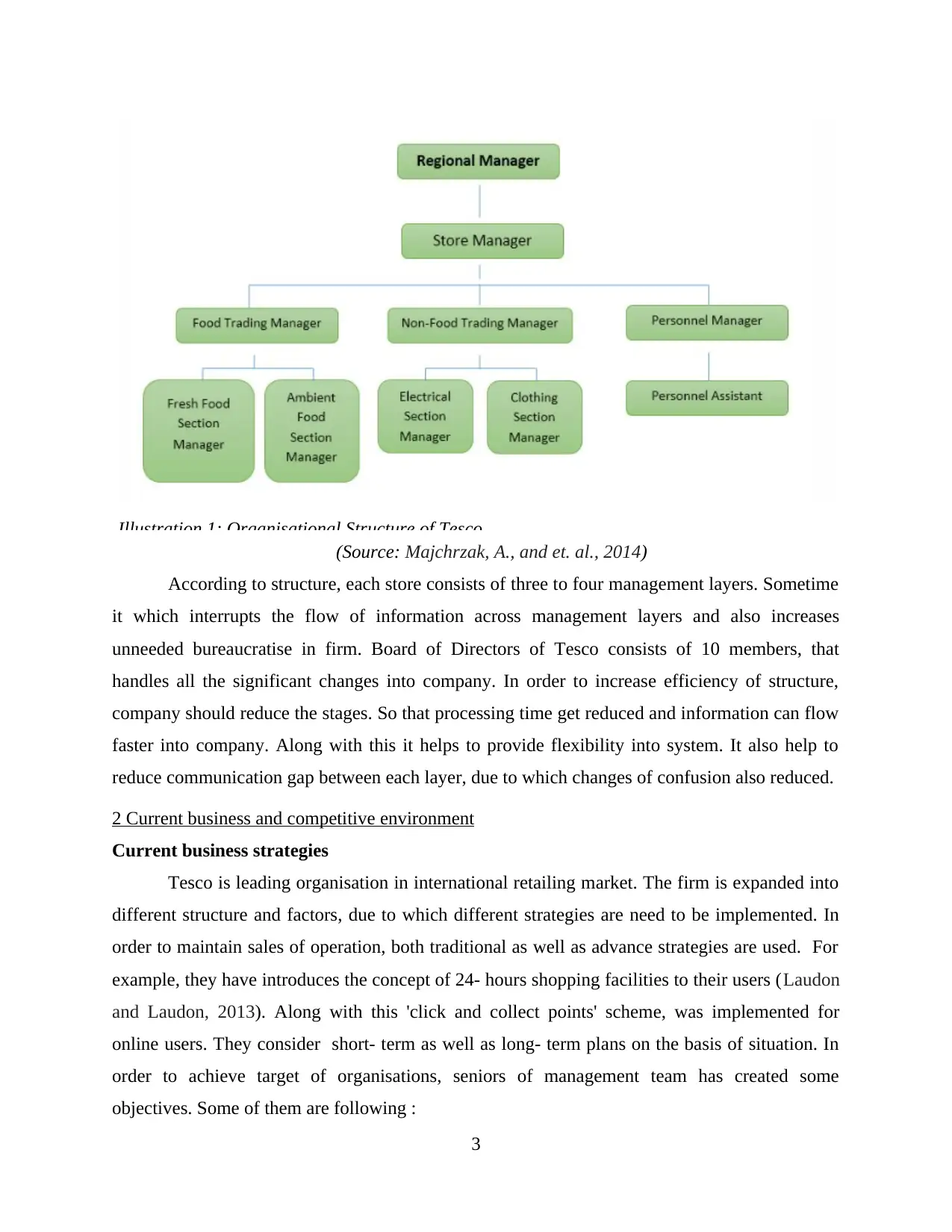
(Source: Majchrzak, A., and et. al., 2014)
According to structure, each store consists of three to four management layers. Sometime
it which interrupts the flow of information across management layers and also increases
unneeded bureaucratise in firm. Board of Directors of Tesco consists of 10 members, that
handles all the significant changes into company. In order to increase efficiency of structure,
company should reduce the stages. So that processing time get reduced and information can flow
faster into company. Along with this it helps to provide flexibility into system. It also help to
reduce communication gap between each layer, due to which changes of confusion also reduced.
2 Current business and competitive environment
Current business strategies
Tesco is leading organisation in international retailing market. The firm is expanded into
different structure and factors, due to which different strategies are need to be implemented. In
order to maintain sales of operation, both traditional as well as advance strategies are used. For
example, they have introduces the concept of 24- hours shopping facilities to their users (Laudon
and Laudon, 2013). Along with this 'click and collect points' scheme, was implemented for
online users. They consider short- term as well as long- term plans on the basis of situation. In
order to achieve target of organisations, seniors of management team has created some
objectives. Some of them are following :
3
Illustration 1: Organisational Structure of Tesco
According to structure, each store consists of three to four management layers. Sometime
it which interrupts the flow of information across management layers and also increases
unneeded bureaucratise in firm. Board of Directors of Tesco consists of 10 members, that
handles all the significant changes into company. In order to increase efficiency of structure,
company should reduce the stages. So that processing time get reduced and information can flow
faster into company. Along with this it helps to provide flexibility into system. It also help to
reduce communication gap between each layer, due to which changes of confusion also reduced.
2 Current business and competitive environment
Current business strategies
Tesco is leading organisation in international retailing market. The firm is expanded into
different structure and factors, due to which different strategies are need to be implemented. In
order to maintain sales of operation, both traditional as well as advance strategies are used. For
example, they have introduces the concept of 24- hours shopping facilities to their users (Laudon
and Laudon, 2013). Along with this 'click and collect points' scheme, was implemented for
online users. They consider short- term as well as long- term plans on the basis of situation. In
order to achieve target of organisations, seniors of management team has created some
objectives. Some of them are following :
3
Illustration 1: Organisational Structure of Tesco
⊘ This is a preview!⊘
Do you want full access?
Subscribe today to unlock all pages.

Trusted by 1+ million students worldwide
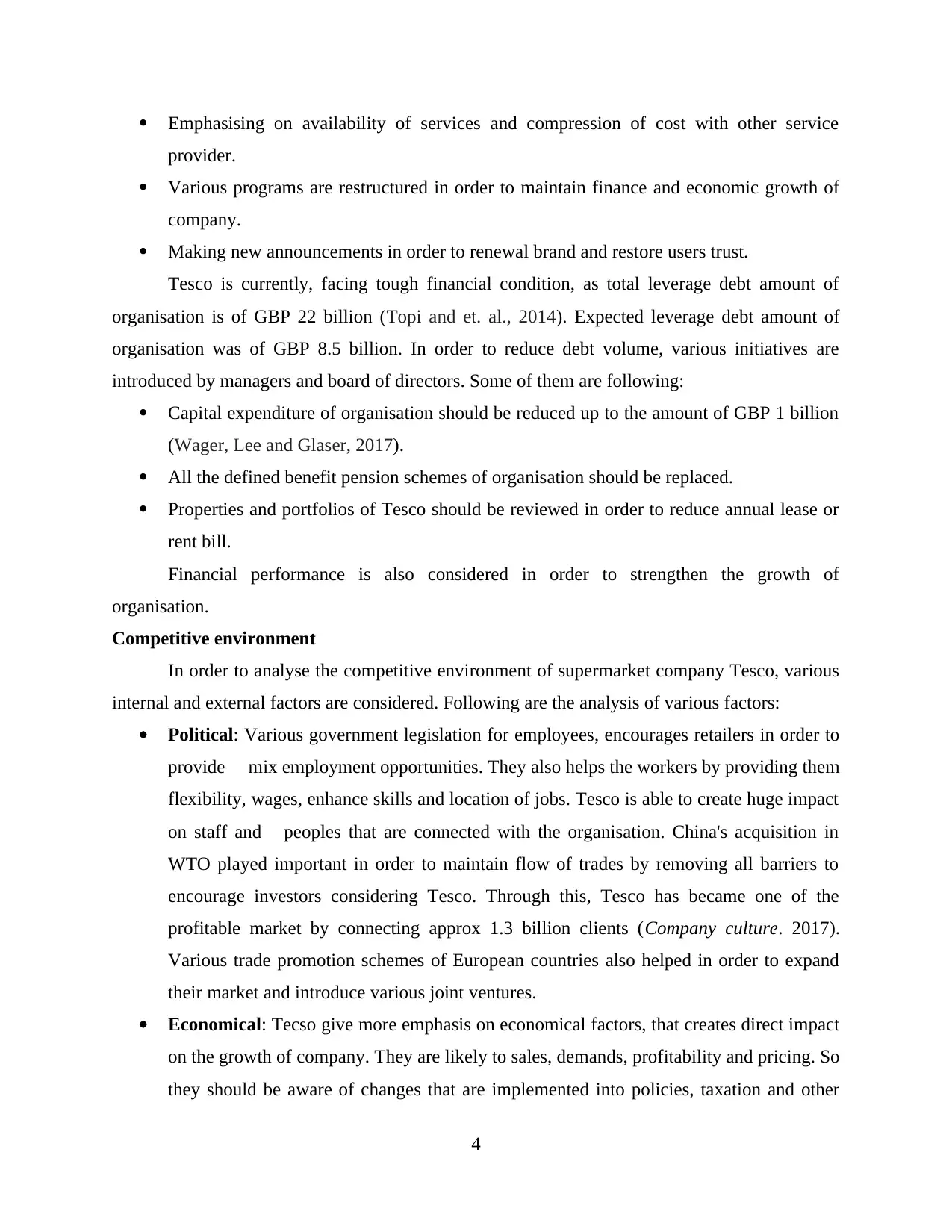
Emphasising on availability of services and compression of cost with other service
provider.
Various programs are restructured in order to maintain finance and economic growth of
company.
Making new announcements in order to renewal brand and restore users trust.
Tesco is currently, facing tough financial condition, as total leverage debt amount of
organisation is of GBP 22 billion (Topi and et. al., 2014). Expected leverage debt amount of
organisation was of GBP 8.5 billion. In order to reduce debt volume, various initiatives are
introduced by managers and board of directors. Some of them are following:
Capital expenditure of organisation should be reduced up to the amount of GBP 1 billion
(Wager, Lee and Glaser, 2017).
All the defined benefit pension schemes of organisation should be replaced.
Properties and portfolios of Tesco should be reviewed in order to reduce annual lease or
rent bill.
Financial performance is also considered in order to strengthen the growth of
organisation.
Competitive environment
In order to analyse the competitive environment of supermarket company Tesco, various
internal and external factors are considered. Following are the analysis of various factors:
Political: Various government legislation for employees, encourages retailers in order to
provide mix employment opportunities. They also helps the workers by providing them
flexibility, wages, enhance skills and location of jobs. Tesco is able to create huge impact
on staff and peoples that are connected with the organisation. China's acquisition in
WTO played important in order to maintain flow of trades by removing all barriers to
encourage investors considering Tesco. Through this, Tesco has became one of the
profitable market by connecting approx 1.3 billion clients (Company culture. 2017).
Various trade promotion schemes of European countries also helped in order to expand
their market and introduce various joint ventures.
Economical: Tecso give more emphasis on economical factors, that creates direct impact
on the growth of company. They are likely to sales, demands, profitability and pricing. So
they should be aware of changes that are implemented into policies, taxation and other
4
provider.
Various programs are restructured in order to maintain finance and economic growth of
company.
Making new announcements in order to renewal brand and restore users trust.
Tesco is currently, facing tough financial condition, as total leverage debt amount of
organisation is of GBP 22 billion (Topi and et. al., 2014). Expected leverage debt amount of
organisation was of GBP 8.5 billion. In order to reduce debt volume, various initiatives are
introduced by managers and board of directors. Some of them are following:
Capital expenditure of organisation should be reduced up to the amount of GBP 1 billion
(Wager, Lee and Glaser, 2017).
All the defined benefit pension schemes of organisation should be replaced.
Properties and portfolios of Tesco should be reviewed in order to reduce annual lease or
rent bill.
Financial performance is also considered in order to strengthen the growth of
organisation.
Competitive environment
In order to analyse the competitive environment of supermarket company Tesco, various
internal and external factors are considered. Following are the analysis of various factors:
Political: Various government legislation for employees, encourages retailers in order to
provide mix employment opportunities. They also helps the workers by providing them
flexibility, wages, enhance skills and location of jobs. Tesco is able to create huge impact
on staff and peoples that are connected with the organisation. China's acquisition in
WTO played important in order to maintain flow of trades by removing all barriers to
encourage investors considering Tesco. Through this, Tesco has became one of the
profitable market by connecting approx 1.3 billion clients (Company culture. 2017).
Various trade promotion schemes of European countries also helped in order to expand
their market and introduce various joint ventures.
Economical: Tecso give more emphasis on economical factors, that creates direct impact
on the growth of company. They are likely to sales, demands, profitability and pricing. So
they should be aware of changes that are implemented into policies, taxation and other
4
Paraphrase This Document
Need a fresh take? Get an instant paraphrase of this document with our AI Paraphraser
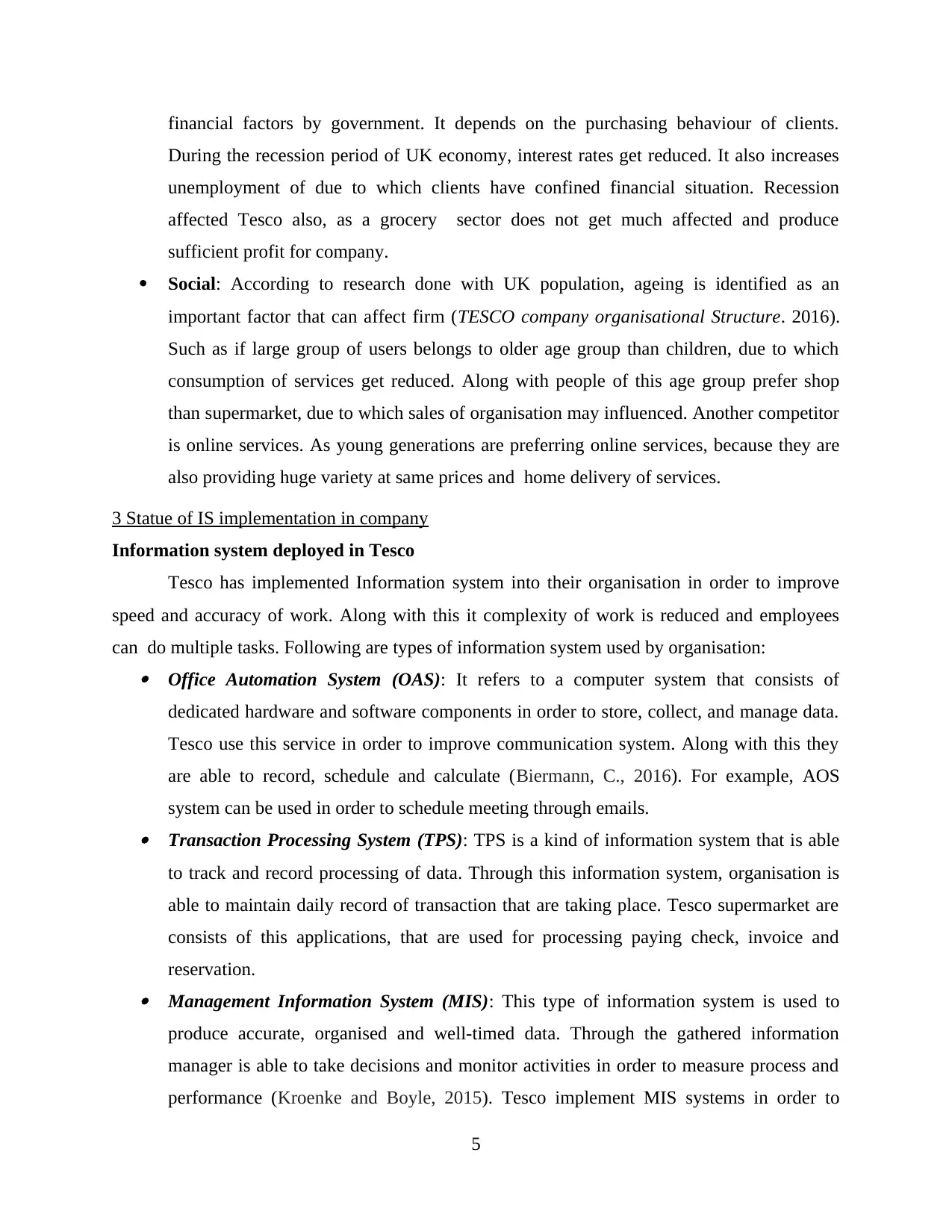
financial factors by government. It depends on the purchasing behaviour of clients.
During the recession period of UK economy, interest rates get reduced. It also increases
unemployment of due to which clients have confined financial situation. Recession
affected Tesco also, as a grocery sector does not get much affected and produce
sufficient profit for company.
Social: According to research done with UK population, ageing is identified as an
important factor that can affect firm (TESCO company organisational Structure. 2016).
Such as if large group of users belongs to older age group than children, due to which
consumption of services get reduced. Along with people of this age group prefer shop
than supermarket, due to which sales of organisation may influenced. Another competitor
is online services. As young generations are preferring online services, because they are
also providing huge variety at same prices and home delivery of services.
3 Statue of IS implementation in company
Information system deployed in Tesco
Tesco has implemented Information system into their organisation in order to improve
speed and accuracy of work. Along with this it complexity of work is reduced and employees
can do multiple tasks. Following are types of information system used by organisation: Office Automation System (OAS): It refers to a computer system that consists of
dedicated hardware and software components in order to store, collect, and manage data.
Tesco use this service in order to improve communication system. Along with this they
are able to record, schedule and calculate (Biermann, C., 2016). For example, AOS
system can be used in order to schedule meeting through emails. Transaction Processing System (TPS): TPS is a kind of information system that is able
to track and record processing of data. Through this information system, organisation is
able to maintain daily record of transaction that are taking place. Tesco supermarket are
consists of this applications, that are used for processing paying check, invoice and
reservation. Management Information System (MIS): This type of information system is used to
produce accurate, organised and well-timed data. Through the gathered information
manager is able to take decisions and monitor activities in order to measure process and
performance (Kroenke and Boyle, 2015). Tesco implement MIS systems in order to
5
During the recession period of UK economy, interest rates get reduced. It also increases
unemployment of due to which clients have confined financial situation. Recession
affected Tesco also, as a grocery sector does not get much affected and produce
sufficient profit for company.
Social: According to research done with UK population, ageing is identified as an
important factor that can affect firm (TESCO company organisational Structure. 2016).
Such as if large group of users belongs to older age group than children, due to which
consumption of services get reduced. Along with people of this age group prefer shop
than supermarket, due to which sales of organisation may influenced. Another competitor
is online services. As young generations are preferring online services, because they are
also providing huge variety at same prices and home delivery of services.
3 Statue of IS implementation in company
Information system deployed in Tesco
Tesco has implemented Information system into their organisation in order to improve
speed and accuracy of work. Along with this it complexity of work is reduced and employees
can do multiple tasks. Following are types of information system used by organisation: Office Automation System (OAS): It refers to a computer system that consists of
dedicated hardware and software components in order to store, collect, and manage data.
Tesco use this service in order to improve communication system. Along with this they
are able to record, schedule and calculate (Biermann, C., 2016). For example, AOS
system can be used in order to schedule meeting through emails. Transaction Processing System (TPS): TPS is a kind of information system that is able
to track and record processing of data. Through this information system, organisation is
able to maintain daily record of transaction that are taking place. Tesco supermarket are
consists of this applications, that are used for processing paying check, invoice and
reservation. Management Information System (MIS): This type of information system is used to
produce accurate, organised and well-timed data. Through the gathered information
manager is able to take decisions and monitor activities in order to measure process and
performance (Kroenke and Boyle, 2015). Tesco implement MIS systems in order to
5
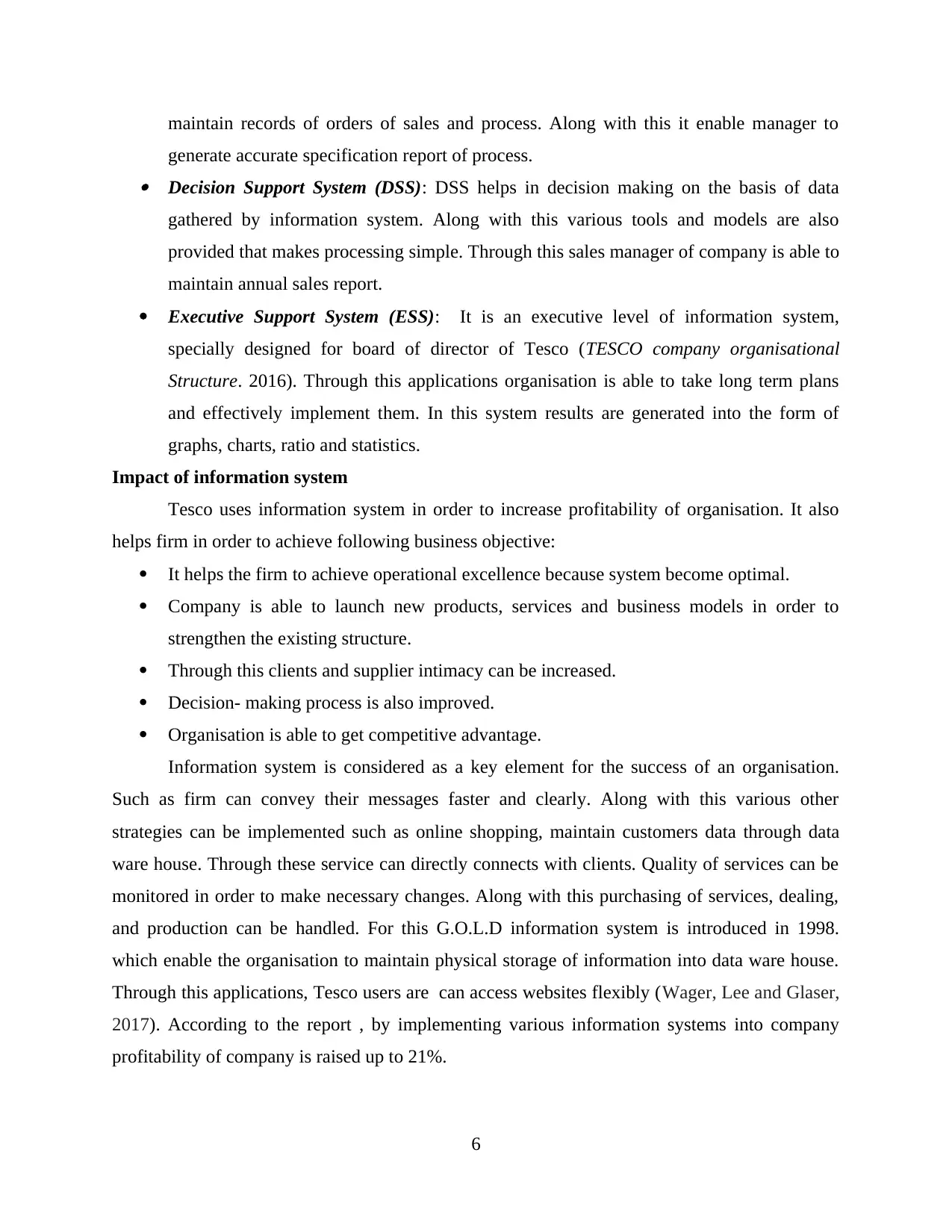
maintain records of orders of sales and process. Along with this it enable manager to
generate accurate specification report of process. Decision Support System (DSS): DSS helps in decision making on the basis of data
gathered by information system. Along with this various tools and models are also
provided that makes processing simple. Through this sales manager of company is able to
maintain annual sales report.
Executive Support System (ESS): It is an executive level of information system,
specially designed for board of director of Tesco (TESCO company organisational
Structure. 2016). Through this applications organisation is able to take long term plans
and effectively implement them. In this system results are generated into the form of
graphs, charts, ratio and statistics.
Impact of information system
Tesco uses information system in order to increase profitability of organisation. It also
helps firm in order to achieve following business objective:
It helps the firm to achieve operational excellence because system become optimal.
Company is able to launch new products, services and business models in order to
strengthen the existing structure.
Through this clients and supplier intimacy can be increased.
Decision- making process is also improved.
Organisation is able to get competitive advantage.
Information system is considered as a key element for the success of an organisation.
Such as firm can convey their messages faster and clearly. Along with this various other
strategies can be implemented such as online shopping, maintain customers data through data
ware house. Through these service can directly connects with clients. Quality of services can be
monitored in order to make necessary changes. Along with this purchasing of services, dealing,
and production can be handled. For this G.O.L.D information system is introduced in 1998.
which enable the organisation to maintain physical storage of information into data ware house.
Through this applications, Tesco users are can access websites flexibly (Wager, Lee and Glaser,
2017). According to the report , by implementing various information systems into company
profitability of company is raised up to 21%.
6
generate accurate specification report of process. Decision Support System (DSS): DSS helps in decision making on the basis of data
gathered by information system. Along with this various tools and models are also
provided that makes processing simple. Through this sales manager of company is able to
maintain annual sales report.
Executive Support System (ESS): It is an executive level of information system,
specially designed for board of director of Tesco (TESCO company organisational
Structure. 2016). Through this applications organisation is able to take long term plans
and effectively implement them. In this system results are generated into the form of
graphs, charts, ratio and statistics.
Impact of information system
Tesco uses information system in order to increase profitability of organisation. It also
helps firm in order to achieve following business objective:
It helps the firm to achieve operational excellence because system become optimal.
Company is able to launch new products, services and business models in order to
strengthen the existing structure.
Through this clients and supplier intimacy can be increased.
Decision- making process is also improved.
Organisation is able to get competitive advantage.
Information system is considered as a key element for the success of an organisation.
Such as firm can convey their messages faster and clearly. Along with this various other
strategies can be implemented such as online shopping, maintain customers data through data
ware house. Through these service can directly connects with clients. Quality of services can be
monitored in order to make necessary changes. Along with this purchasing of services, dealing,
and production can be handled. For this G.O.L.D information system is introduced in 1998.
which enable the organisation to maintain physical storage of information into data ware house.
Through this applications, Tesco users are can access websites flexibly (Wager, Lee and Glaser,
2017). According to the report , by implementing various information systems into company
profitability of company is raised up to 21%.
6
⊘ This is a preview!⊘
Do you want full access?
Subscribe today to unlock all pages.

Trusted by 1+ million students worldwide
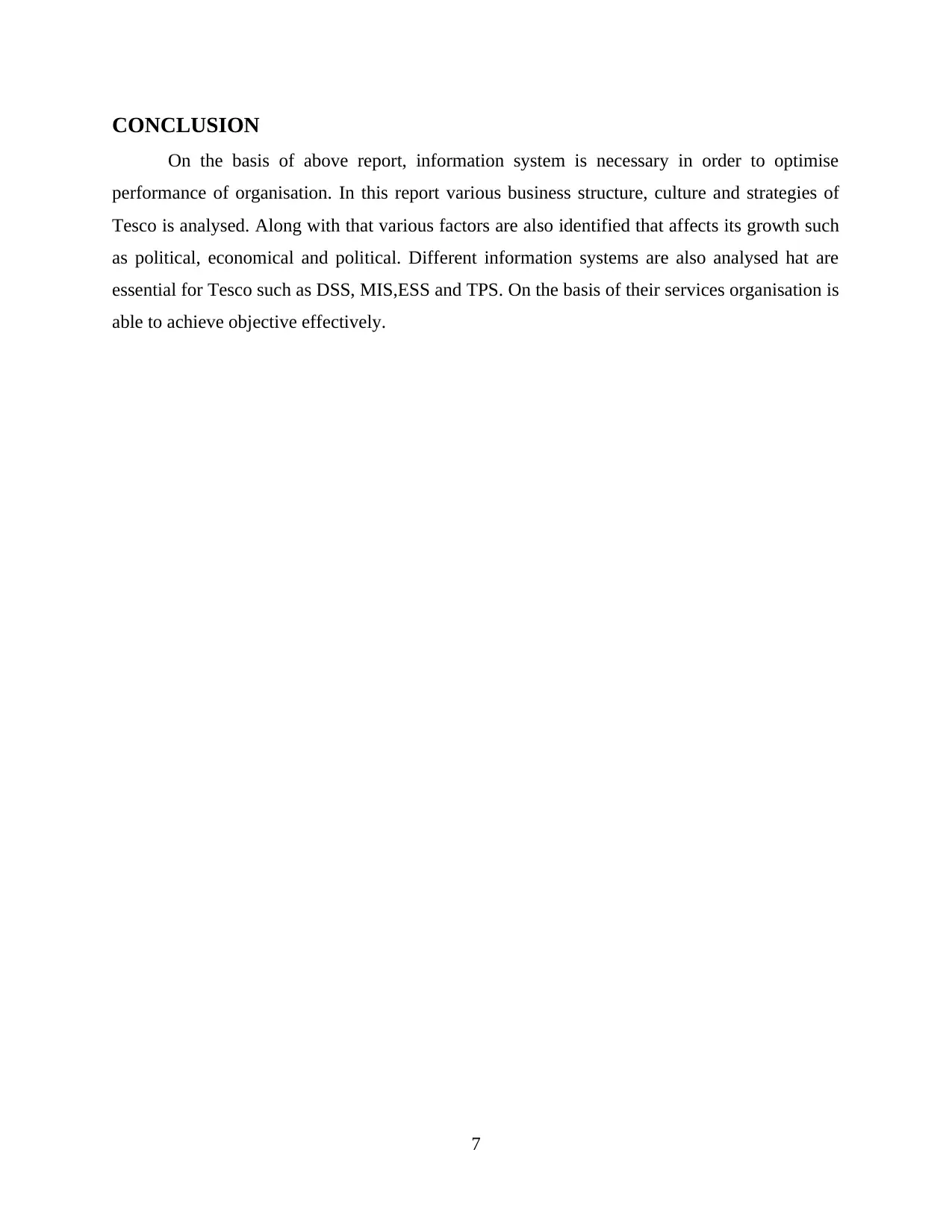
CONCLUSION
On the basis of above report, information system is necessary in order to optimise
performance of organisation. In this report various business structure, culture and strategies of
Tesco is analysed. Along with that various factors are also identified that affects its growth such
as political, economical and political. Different information systems are also analysed hat are
essential for Tesco such as DSS, MIS,ESS and TPS. On the basis of their services organisation is
able to achieve objective effectively.
7
On the basis of above report, information system is necessary in order to optimise
performance of organisation. In this report various business structure, culture and strategies of
Tesco is analysed. Along with that various factors are also identified that affects its growth such
as political, economical and political. Different information systems are also analysed hat are
essential for Tesco such as DSS, MIS,ESS and TPS. On the basis of their services organisation is
able to achieve objective effectively.
7
Paraphrase This Document
Need a fresh take? Get an instant paraphrase of this document with our AI Paraphraser
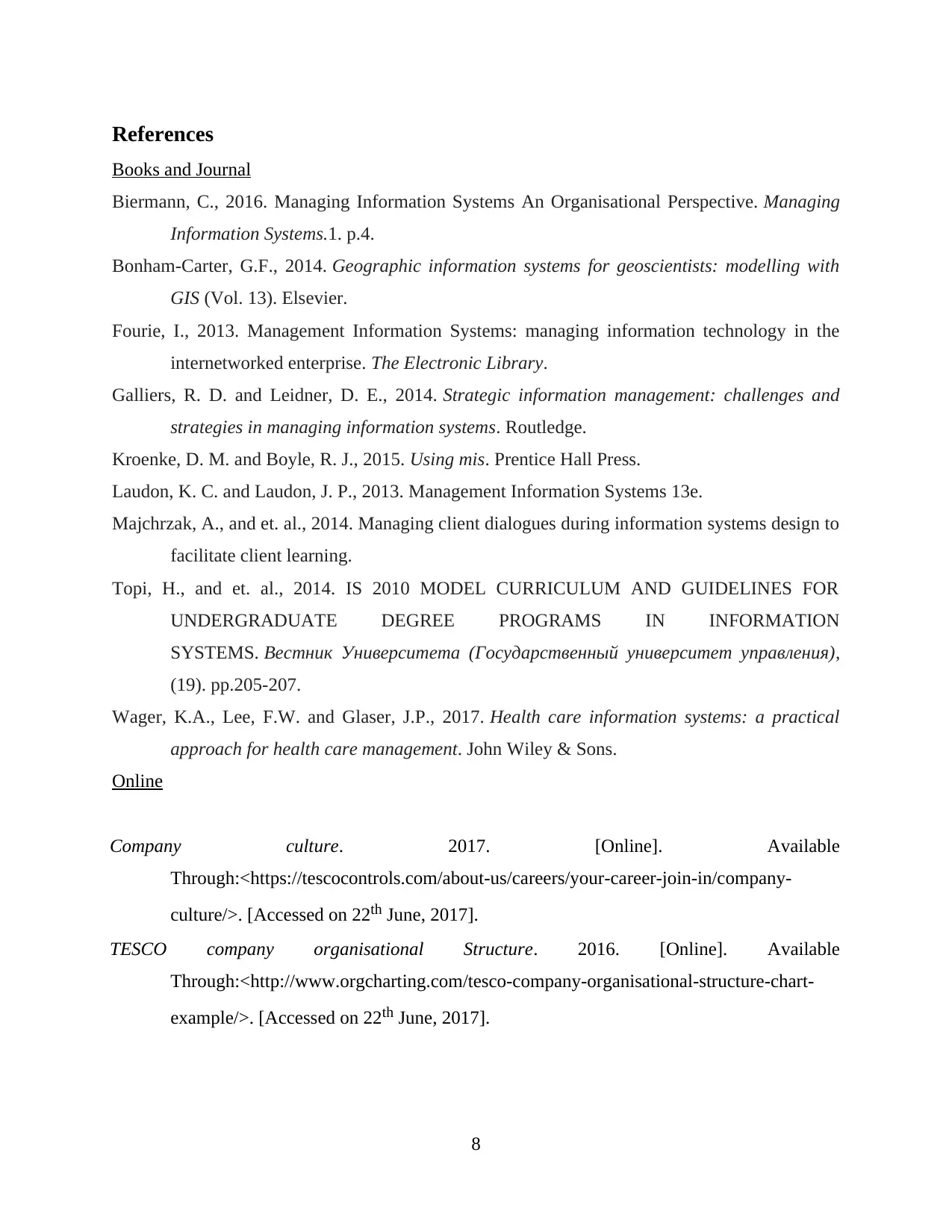
References
Books and Journal
Biermann, C., 2016. Managing Information Systems An Organisational Perspective. Managing
Information Systems.1. p.4.
Bonham-Carter, G.F., 2014. Geographic information systems for geoscientists: modelling with
GIS (Vol. 13). Elsevier.
Fourie, I., 2013. Management Information Systems: managing information technology in the
internetworked enterprise. The Electronic Library.
Galliers, R. D. and Leidner, D. E., 2014. Strategic information management: challenges and
strategies in managing information systems. Routledge.
Kroenke, D. M. and Boyle, R. J., 2015. Using mis. Prentice Hall Press.
Laudon, K. C. and Laudon, J. P., 2013. Management Information Systems 13e.
Majchrzak, A., and et. al., 2014. Managing client dialogues during information systems design to
facilitate client learning.
Topi, H., and et. al., 2014. IS 2010 MODEL CURRICULUM AND GUIDELINES FOR
UNDERGRADUATE DEGREE PROGRAMS IN INFORMATION
SYSTEMS. Вестник Университета (Государственный университет управления),
(19). pp.205-207.
Wager, K.A., Lee, F.W. and Glaser, J.P., 2017. Health care information systems: a practical
approach for health care management. John Wiley & Sons.
Online
Company culture. 2017. [Online]. Available
Through:<https://tescocontrols.com/about-us/careers/your-career-join-in/company-
culture/>. [Accessed on 22th June, 2017].
TESCO company organisational Structure. 2016. [Online]. Available
Through:<http://www.orgcharting.com/tesco-company-organisational-structure-chart-
example/>. [Accessed on 22th June, 2017].
8
Books and Journal
Biermann, C., 2016. Managing Information Systems An Organisational Perspective. Managing
Information Systems.1. p.4.
Bonham-Carter, G.F., 2014. Geographic information systems for geoscientists: modelling with
GIS (Vol. 13). Elsevier.
Fourie, I., 2013. Management Information Systems: managing information technology in the
internetworked enterprise. The Electronic Library.
Galliers, R. D. and Leidner, D. E., 2014. Strategic information management: challenges and
strategies in managing information systems. Routledge.
Kroenke, D. M. and Boyle, R. J., 2015. Using mis. Prentice Hall Press.
Laudon, K. C. and Laudon, J. P., 2013. Management Information Systems 13e.
Majchrzak, A., and et. al., 2014. Managing client dialogues during information systems design to
facilitate client learning.
Topi, H., and et. al., 2014. IS 2010 MODEL CURRICULUM AND GUIDELINES FOR
UNDERGRADUATE DEGREE PROGRAMS IN INFORMATION
SYSTEMS. Вестник Университета (Государственный университет управления),
(19). pp.205-207.
Wager, K.A., Lee, F.W. and Glaser, J.P., 2017. Health care information systems: a practical
approach for health care management. John Wiley & Sons.
Online
Company culture. 2017. [Online]. Available
Through:<https://tescocontrols.com/about-us/careers/your-career-join-in/company-
culture/>. [Accessed on 22th June, 2017].
TESCO company organisational Structure. 2016. [Online]. Available
Through:<http://www.orgcharting.com/tesco-company-organisational-structure-chart-
example/>. [Accessed on 22th June, 2017].
8
1 out of 11
Related Documents
Your All-in-One AI-Powered Toolkit for Academic Success.
+13062052269
info@desklib.com
Available 24*7 on WhatsApp / Email
![[object Object]](/_next/static/media/star-bottom.7253800d.svg)
Unlock your academic potential
Copyright © 2020–2025 A2Z Services. All Rights Reserved. Developed and managed by ZUCOL.





